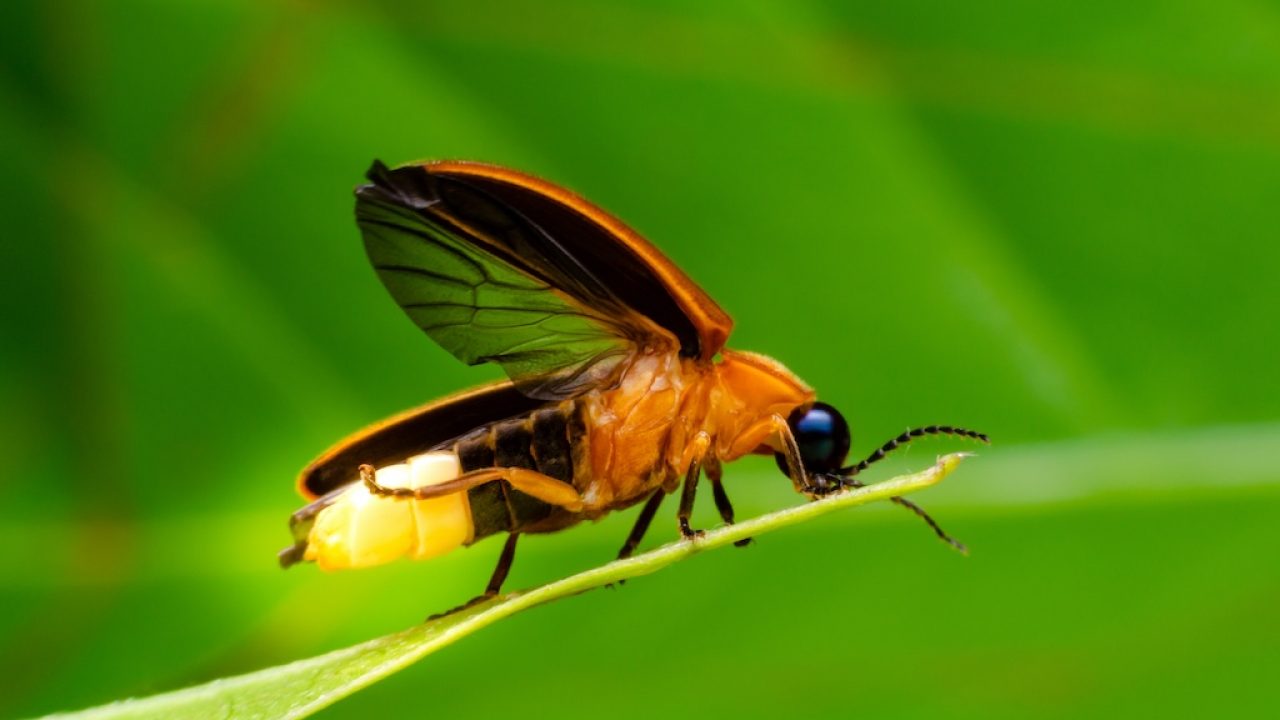
© Shutterstock
Musa Sattar, London, UK – Deputy Science Editor
On warm summer nights, as the sun sets and the sky turns into a canvas of stars, something magical stirs in meadows, forests, and backyards. Tiny flickers of light appear in the dark, dancing just above the ground like living stars. These glowing creatures are fireflies – or lightning bugs, as some call them – and they carry a secret: inside their small bodies, they hold a natural lantern that lights up the night. It is a soft, gentle glow – never harsh like a flashlight but warm and enchanting, as if nature is whispering its secrets to the world.
With over 2,000 species found across the globe (except in Antarctica), fireflies inhabit warm, humid regions like forests, meadows, and marshlands. Though they vary in appearance and size, ranging from just 5 millimetres to 2.5 centimetres long, all fireflies share one incredible ability: they produce light without heat, something human technology still can’t replicate. Fireflies’ delicate body, capable of producing efficient light, exemplifies a precision that cannot be dismissed as mere chance.
Though small, their glowing light travels far, making them stand out against the darkness, and yet, when the daylight comes, they blend back into the background as they turn their light off at will.
But how does a firefly manage this incredible feat? Inside its abdomen, a chemical reaction called bioluminescence occurs. Special cells in the firefly’s lantern organ found in its abdomen are packed with luciferin and luciferase – two remarkable chemicals that, when combined with oxygen, produce the firefly’s glow. In these intricate processes, we see the hallmark of a Creator who intricately designs even the smallest of beings to function with exactness and beauty.
Despite their delicate appearance, these little creatures have a complex body structure that allows them to do what, as of yet, no human-made technology can: produce light without heat.
Firefly glow isn’t like sunlight or the glow of a flame, which is too hot to touch. Instead, it’s a ‘cold’ light. Interestingly, this ‘cold light’ is 100% efficient, meaning no energy is wasted as heat – a feat that modern technology is yet to match. In fact, while traditional light bulbs waste around 90% of energy as heat, a firefly’s light loses none. If a firefly’s light-producing organ generated as much heat as a light bulb, the creature would not survive the experience. It’s as if nature itself created the perfect lighting system, one that is not only efficient but also captivating. This precision, seen even in the smallest details of nature, reflects the wisdom of a Supreme Creator.
While many associate the firefly’s glow with courtship rituals, the story is more complex. Fireflies don’t just glow to find mates. Their light also serves as a warning to predators. Fireflies contain bitter chemicals called lucibufagins, which are toxic or unpalatable to predators like birds or amphibians. As Professor Clyde Sorenson of North Carolina State University observed: ‘I once saw a toad eat a firefly and promptly spit it out. The firefly walked away, gooey but unharmed.’ This defence mechanism is just another example of the firefly’s intricate design – perfectly suited for survival.
Fireflies don’t glow all the time. They have complete control over their light, turning it on and off at will. Each species has its own unique flash pattern, which serves as a communication system – particularly during mating season. Male fireflies fly around, flashing in specific rhythms, while females on the ground respond if they find the signal appealing. In this ‘light language,’ male fireflies court potential mates not with sounds or movements, but with carefully timed flashes of light. According to Clyde Sorenson, ‘They’re extremely charismatic.’ Some species, like Photinus pyralis, emit quick, simple flashes, while others use slower, more intricate patterns. In places like Appalachia, thousands of fireflies synchronise their flashes, creating waves of light that ripple through fields and forests in perfect harmony, creating a spectacular natural phenomenon. This synchronised flashing, especially prominent in Southeast Asia, transforms entire trees into glowing beacons – a spectacle so breath-taking that it has been compared to nature’s own Christmas lights. Science writer Joanna Thompson beautifully captured the enchantment of fireflies, describing them as ‘a tiny galaxy descended into the forest.’
Interestingly, Hazrat Mirza Tahir Ahmad (rh), the Fourth Caliph of the Ahmadiyya Muslim Community, has drawn a comparison between this phenomenon and the prayers of believers. Addressing his Community, he states:
‘When the entire Community prays, it cannot be said whose prayer is accepted. As a whole, the Community expresses humility before God, and often, that collective prayer has an effect as a whole. At times, those participating in the gathering experience different spiritual states at different times; certain feelings arise in their hearts, and these special conditions play a significant role in the acceptance of prayers.
Therefore, when a large group of the Community is praying, it is similar to fireflies shining in the dark. There are countless fireflies, some of which are glowing while others are not, yet the overall impression is that the night has become illuminated. Once, in the Sundarbans region of Eastern Bengal, I witnessed this scene. The entire forest was lit up, and it was glowing because of the fireflies. Even though nearly half of the fireflies were not glowing at any given moment, the others that were still glowing created an effect where not a single moment appeared dark.
Similarly, the blessing of collective prayer is such that different inspirations and spiritual stirrings arise in the hearts of some of God’s servants at various times, and they are granted moments of acceptance. Thus, throughout this entire period, not a single moment passes in the collective life of a believer where there is no light. Hence, it is essential for Ahmadis around the world to remain continuously engaged in abundant prayers.’[1]
Scientists still aren’t entirely clear on how these lightning bugs synchronise their flashes. Such awe-inspiring beauty naturally draws our thoughts to the Creator, whose design and artistry are evident in even the smallest of creatures.
Beyond mating and defence, fireflies are part of a larger ecological system. Their larvae, known as glowworms, live in soil and leaf litter, where they feed on small insects, and even larger ones such as slugs and snails. Glowworms are also bioluminescent, using their glow to ward off predators even in this early stage. A female firefly can lay up to 500 eggs in her lifetime, but only a few survive to adulthood. These larvae spend up to two years growing and molting, waiting for the right moment to transform into adult fireflies. Adult fireflies, however, live for just a few weeks – long enough to find a mate and continue the cycle.
The firefly offers a profound example of how every detail in creation, no matter how small or seemingly insignificant, points to the wisdom of its Supreme Creator, the One Who designs both the vastness of the universe and the tiniest of creatures with the same perfection. Just as John Ruskin once observed, the system of the world is interconnected – small and great alike are part of one grand design. A firefly, though visually unremarkable in daylight, transforms into a wonder of light and complexity when night falls.
Interestingly, not all fireflies glow. Some species, such as those in the genus Ellychnia, are ‘dark’ fireflies that communicate using pheromones (chemical signals) instead of light. While they don’t participate in the light show, they still play an important role in maintaining their ecosystems. Their existence, even without bioluminescence, reminds us of the diversity and complexity of nature’s designs.
Fireflies’ ability to produce cold, efficient light exemplifies precision engineering, something that even our most advanced technology struggles to match. Scientists have tried to mimic their light for decades, but we are still far from achieving the firefly’s level of efficiency. As biologist Andrew Moiseff noted, fireflies have been using principles similar to computer science long before humans discovered them. Researchers continue to study how these insects synchronise their flashes, hoping to unlock the secrets behind their perfect coordination.
For many, the sight of fireflies brings back childhood memories – of warm summer nights chasing their glow and marvelling at their silent, flickering dance. There is something timeless about the firefly’s light, something that makes us pause and reflect on the beauty around us. Even as science advances, the firefly’s glow reminds us of the mysteries we have yet to uncover. In their light, we see not just a signal to other fireflies but also a signal to us – a reminder to appreciate the wonders of the natural world.
No doubt, the firefly’s design – from its tiny body to its flawless light – is a reflection of the Divine Hand behind all creation. Each flash is a testimony to a Creator Who fashioned the world with wisdom and interconnected beauty. As American biologist Sara Lewis once said, ‘Fireflies offer us a gift of wonder.’ And the more we marvel at that wonder, the more we uncover the undeniable signs of a Creator’s existence in every intricate detail. So, the next time you step outside on a warm summer night, keep your eyes open for the flicker of a firefly. Let its glow take you on a journey – from the quiet corners of a meadow to the vastness of creation. In that tiny glowing body, you’ll find a universe of wonder – a reminder that the world is full of beauty, even in the most unexpected places.
ENDNOTES
1. Hazrat Mirza Tahir Ahmad (rh), Khutbat-e-Tahir, Vol. 7, 1988, p. 778.
Further Reading:
Lynn Frierson Faust, Fireflies, Glow-Worms, and Lightning Bugs: Identification and Natural History of the Fireflies of the Eastern and Central United States and Canada (Athens: The University of Georgia Press, 2017).
Sara Lewis, Silent Sparks: The Wondrous World of Fireflies (Princeton University Press, 2016).




Add Comment